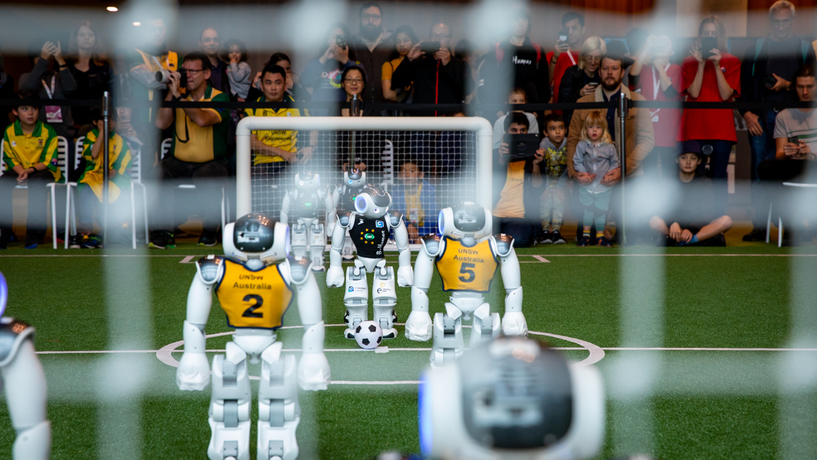After 25 years, we still don't see bicycle kicks at the RoboCup<p>This year’s
RoboCup symposium held in Bangkok, Thailand marks the 25th anniversary of the event, an international competition dedicated to the advancement of robotic and artificial intelligence technologies. The original goal of the cup was to get the state of robotics in robust enough shape that one might field a team of robotic soccer players capable of beating a World Cup champion (human) team by 2050 – but a lot has changed since 1997.</p><figure>

<figcaption></figcaption><div class="photo-credit">RoboCup</div></figure><p>Both the event and its mechanical entrants have evolved by leaps and bounds in the intervening years. The number of teams participating has ballooned tenfold since the inaugural event, from 38 to more than 300, with competitors now coming from more than 40 nations worldwide. And rather than
fall down stairs, today’s cutting-edge humanoid constructs are
backflipping off them.</p><span id="end-legacy-contents"></span><p>“We think of [the competition] as a grand challenge akin to the Apollo missions that sought to land a person on the moon,” said Dr. Peter Stone, Professor of Computer Science at the University of Texas at Austin and Executive Director of Sony AI America. “In both cases, one might reasonably ask, why is it worthwhile to try to achieve such a goal? What do we gain by landing a person on the moon? What do we gain by creating superhuman soccer playing robots?”</p><div id="5d8c4fbde101400887cb655f6d7aa7db"><iframe src="
https://www.youtube.com/embed/YmfXmoWkdw4?rel=0" style="top:0;left:0;width:100%;height:100%;position:absolute;border:0;" allowfullscreen scrolling="no"></iframe></div><p>“In the case of the Apollo mission, there were several spin-off technologies in areas such as remote telemetry, body monitoring, breathing apparatuses, fabric structures, communications, and food packaging,” he continued. ”In the case of RoboCup, there have been several start-up companies founded by RoboCup participants using RoboCup technologies, most prominently Kiva Systems which became Amazon Robotics.”</p><p>“This vision inspired my early research on AI planning and machine learning in multiagent systems,” Stone wrote in a
2021 Sony AI blog, “and has continued to inspire my research and that of my students on these areas and robot learning throughout the years.”</p><p>The ideas that led to the RoboCup — can you use a soccer competition to promote robotics and AI research — had been percolating in the academic space since the early 1990s,
according to RoboCup, though it wasn't until 1995’s International Joint Conference on Artificial Intelligence that the official groundwork for a RoboCup competition was laid. Following a requisite two-year gap for teams to sort out funding and training, Nagoya, Japan hosted the first event with more than 5,000 spectators in attendance.</p><p>Today, teams can compete in both simulated and physical soccer matches using
an array of humanoid robots — sorted into divisions by size, capability, and pedalness — as well as pit their robotic first responders against the Cup’s hazard-strewn disaster courses, best one another at robo-buttling in the @Home competition, and devise the most efficient warehouse floor operation in Industry. There’s even
a dedicated league for junior roboticists that spans the fields of soccer, search and rescue, and on-stage performance.</p><div id="0b4676cfa86c43f09450149b880acaf6"><iframe src="
https://www.youtube.com/embed/ocZKh1QFHjI?rel=0" style="top:0;left:0;width:100%;height:100%;position:absolute;border:0;" allowfullscreen scrolling="no"></iframe></div><p>“One of the most important scientific contributions of RoboCup has been to demonstrate how competitions can drive research and also provide a way of objectively benchmarking different technologies,” said Dr. Claude Sammut, Head of the Artificial Intelligence Research Group at the University of New South Wales and Deputy Director of the iCinema Centre for Interactive Cinema Research.</p><p>Sammut notes RoboCup Rescue as one valuable benchmarking example. The competition is supported, in part, by the US National Institute for Standard and Technology (NIST). “The arena uses the test methods developed by NIST to measure the performance of robots for disaster recovery and ordnance disposal. Each year, the test methods are updated to reflect real-world experience, so teams are encouraged to extend the capabilities of their robots to handle increasingly complex tasks.”</p><p>Training robots to play soccer “is a great problem to work on because it needs progress across most areas of AI and robotics (and it’s fun and motivating for students),” Sammut said, but learning that game won’t teach robots all they need to know about navigating in the wider world. The Cup’s Rescue course requires the robot to overcome unknown terrain to extract victims while @Home demands robust human-robot interaction and planning skills. “Humans working with robots is an important goal, so introducing domestic service robots pushes us in that direction,” he said.</p><div id="7e1c88dca2c941a48ad15db8a8620adb"><iframe src="
https://www.youtube.com/embed/zJ1PYqVOYVA?rel=0&start=13" style="top:0;left:0;width:100%;height:100%;position:absolute;border:0;" allowfullscreen scrolling="no"></iframe></div><p>That skill development has kept apace with the field’s steady stream of hardware advancements. Sammut points to “the massive increases in performance of low cost, low power CPUs and GPUs” to handle a greater degree of processing onboard, as well as the precipitous price drop of sensory equipment. “The first depth camera we bought for our rescue robots in 2006 cost €10,000. Now you can buy much better ones for a few hundred dollars and your iPhone and iPad have them built in.”</p><p>That said, even with a quarter-century of technological advancements, today’s RoboCup competitors more closely resemble old Asimo than they do
Sonny. Matches aren’t so much fast moving spectacles of mechanical might and sport prowess as they are watching a pair of toddling automatons shuffle after a ball while their developers trail behind them, ready to intervene in the event of a misstep or stumble.</p><p>“Motors and batteries have improved somewhat but they need further development to be able to get better speed, agility and lifetime,” Sammut conceded. “Soft, light but strong materials would also make the robots safer to be around. I wouldn't want to be on the field with the current large humanoid robots because a tackle would really hurt!”</p>
Source:
After 25 years, we still don't see bicycle kicks at the RoboCup